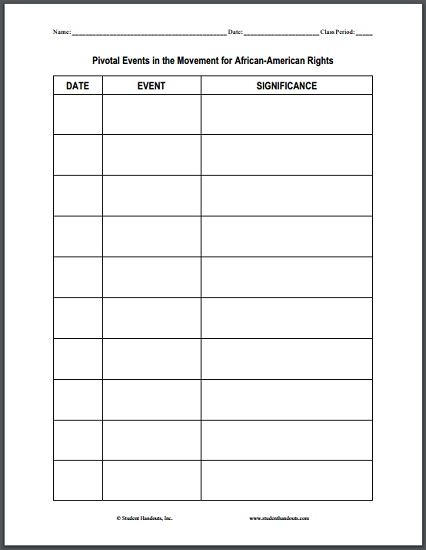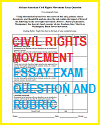| Pivotal Events in the Movement for African-American Rights |
|---|
| www.studenthandouts.com > U.S. History > Decades of Change > Worksheets |
 |  |
|---|
| Students are asked to list and describe major events in the struggle for African-American civil rights. Click here to print (PDF file). Answers will vary. |
|---|
|
The struggle for African-American civil rights in the United States has been marked by numerous major events that have significantly advanced the cause of racial equality. Here are some key milestones: Emancipation Proclamation (1863): Issued by President Abraham Lincoln, this executive order declared the freedom of all enslaved people in Confederate-held territory during the Civil War. It was a crucial step towards ending slavery and laid the groundwork for the 13th Amendment, which abolished slavery in the U.S. Brown v. Board of Education (1954): The U.S. Supreme Court ruled that racial segregation in public schools was unconstitutional. This landmark decision overturned the "separate but equal" doctrine of Plessy v. Ferguson and was a significant victory for the civil rights movement, leading to the desegregation of schools. Montgomery Bus Boycott (1955-1956): Sparked by Rosa Parks' arrest for refusing to give up her bus seat to a white man, African-Americans in Montgomery, Alabama, organized a year-long boycott of the city's bus system. The boycott led to a Supreme Court ruling that segregation on public buses was unconstitutional and propelled Martin Luther King Jr. into national prominence as a civil rights leader. Civil Rights Act of 1964: This landmark legislation outlawed discrimination based on race, color, religion, sex, or national origin and ended segregation in public places and banned employment discrimination. It was a major legislative victory for the civil rights movement and significantly advanced legal and social equality for African-Americans. Voting Rights Act of 1965: This law aimed to overcome legal barriers at the state and local levels that prevented African-Americans from exercising their right to vote. It resulted in a dramatic increase in African-American voter registration and participation and was a crucial step in securing political rights for African-Americans. March on Washington for Jobs and Freedom (1963): Over 250,000 people gathered in Washington, D.C., to advocate for civil and economic rights for African-Americans. Martin Luther King Jr. delivered his iconic "I Have a Dream" speech at this event. The march demonstrated the strength and unity of the civil rights movement and helped build momentum for subsequent civil rights legislation. Selma to Montgomery Marches (1965): These three protest marches were organized to demand voting rights and were met with violent resistance from local authorities and state troopers, particularly on "Bloody Sunday." The brutality witnessed during these marches garnered national attention and contributed to the passage of the Voting Rights Act of 1965. Assassination of Martin Luther King Jr. (1968): The assassination of the prominent civil rights leader in Memphis, Tennessee, led to widespread riots and mourning. King's death galvanized the movement and led to the passage of the Civil Rights Act of 1968, which included fair housing provisions. Civil Rights Act of 1968 (Fair Housing Act): This act prohibited discrimination concerning the sale, rental, and financing of housing based on race, religion, national origin, and later, sex. It extended civil rights protections to the housing market, combating systemic housing discrimination and segregation. Black Lives Matter Movement (2013-Present): This movement began in response to the acquittal of Trayvon Martin's killer and has grown to address broader issues of police brutality and systemic racism. It has brought renewed attention to racial injustice and police violence, influencing public discourse, policy, and activism in the 21st century. These events, among others, have played crucial roles in the ongoing struggle for African-American civil rights, leading to significant legal and social advancements and shaping the fight for racial equality in the United States. |
| www.studenthandouts.com > U.S. History > Decades of Change > Worksheets |









